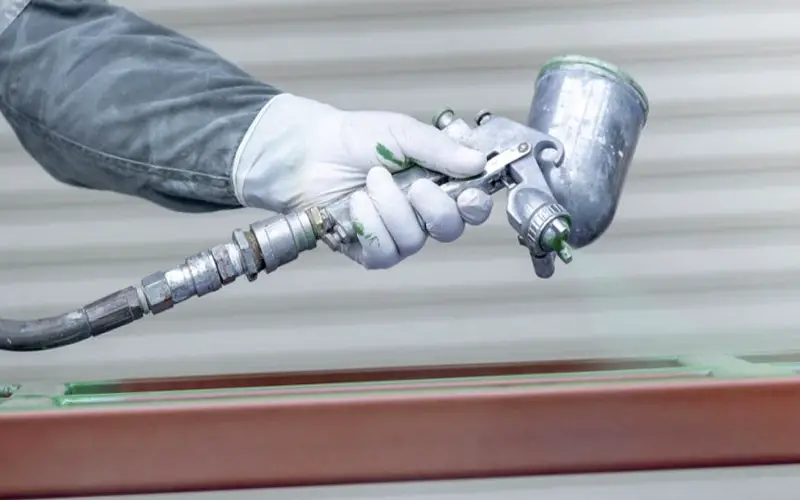So, you’ve finished your latest painting project and you’re left with a paint sprayer clogged with dried paint. Cleaning it might seem like a daunting task, but with the right approach, it’s completely manageable. In this guide, we’ll walk you through the step-by-step process of how to clean a paint sprayer with dried paint, ensuring it’s ready for your next project.
Gathering Necessary Supplies
It’s crucial to acquire all the required materials before beginning the cleaning process. Here’s what you’ll need:
- Cleaning solution (paint thinner or a specialized cleaner)
- Buckets or containers for soaking parts
- Brushes and scrubbing tools (toothbrushes work great for small areas)
- Safety gloves and goggles
- Rags and paper towels
- Replacement filters (if needed)
Safety Precautions
Always wear safety gloves and goggles to protect yourself from harsh chemicals and sharp parts. To prevent breathing in fumes, make sure you’re working in a well-ventilated environment.
Initial Preparation
Disassembling the Paint Sprayer
Start by carefully disassembling your paint sprayer. Refer to your user manual for specific instructions, as each model can be slightly different. Remove the nozzle, hose, and any detachable parts.
Assessing the Extent of the Dried Paint
Take a good look at all the parts to see how much dried paint you’re dealing with. This will help you decide how long to soak the parts and which areas need the most attention.
Soaking the Parts
Choosing the Right Cleaning Solution
Select a cleaning solution appropriate for the type of paint used. For water-based paints, warm soapy water might suffice. For oil-based paints, you’ll need a stronger solvent like paint thinner or a specialized cleaner.
Soaking Duration and Tips
After submerging the parts, let them soak in the cleaning solution. For heavy build-up, you might need to soak them overnight. Ensure all parts are fully submerged for the best results.
Scrubbing and Cleaning the Parts
Tools for Scrubbing

Use small brushes, like old toothbrushes, to scrub the parts. Brushes with stiff bristles work best for stubborn paint.
Techniques for Effective Cleaning
Scrub each part thoroughly, paying extra attention to areas with heavy paint build-up. Rotate the parts to ensure all angles are cleaned.
Cleaning the Nozzle
Importance of Nozzle Maintenance
The nozzle is critical for the sprayer’s performance. A clogged nozzle can cause uneven spray patterns and poor results.
Steps to Clean a Clogged Nozzle
Use a fine brush or a needle to clean the nozzle. If it’s severely clogged, soaking it in a solvent may help loosen the dried paint.
Cleaning the Filters
Role of Filters in a Paint Sprayer
Filters prevent debris from entering the paint sprayer and clogging the nozzle. Keeping them clean ensures smooth operation.
How to Properly Clean and Replace Filters
Remove the filters and soak them in the cleaning solution. Before reassembling, give them a good water rinse and allow them to air dry entirely. If the filters are too clogged, consider replacing them.
Cleaning the Hose
Challenges of Cleaning the Hose
Hoses can be tricky to clean due to their length and flexibility. Paint can easily dry and harden inside, causing blockages.
Effective Methods for Hose Cleaning
Attach the hose to a water source and flush it out with high-pressure water. You can also use a small brush or a flexible cleaning tool designed for hoses.
Reassembling the Paint Sprayer
Step-by-Step Reassembly Guide
Reassemble the sprayer once every component has been cleaned and allowed to dry. Follow your user manual to ensure each part is correctly fitted.
Ensuring All Parts are Properly Fitted
Double-check that all connections are tight and secure. This keeps leaks from happening and guarantees that the sprayer runs properly.
Final Rinse and Test
Importance of a Final Rinse
Give the assembled sprayer a final rinse with clean water or a suitable solvent. This removes any residual cleaning solution.
Testing the Paint Sprayer for Functionality
Test the sprayer with water to ensure it’s working correctly. Check for smooth operation and even spray painting.
Preventative Maintenance Tips
Regular Cleaning Schedule
Establish a routine cleaning schedule based on how often you use your sprayer. Maintaining the system regularly keeps paint from drying and fouling it.
Tips to Prevent Paint from Drying in the Sprayer
Always clean the sprayer immediately after use. If you need to pause your project, keep the sprayer submerged in water or solvent to prevent the paint from drying.
Dealing with Stubborn Dried Paint
Specialized Products for Tough Jobs
If dried paint is very difficult to remove, you might want to use specialty paint sprayer cleansers. These products are designed to break down and dissolve dried paint more effectively.
Professional Cleaning Services
If all else fails, you might need to take your sprayer to a professional cleaning service. They have the tools and expertise to thoroughly clean your equipment.
Environmental Considerations
Proper Disposal of Cleaning Solutions
Follow local laws while discarding used cleaning supplies. Many solvents are hazardous and need to be disposed of at designated facilities.
Eco-friendly Cleaning Alternatives
Whenever possible, use eco-friendly cleaning products. They’re less harmful to the environment and safer for you to use.
Common Mistakes to Avoid
Avoiding Damage to the Sprayer
Don’t use excessive force when scrubbing or disassembling parts. This can damage the sprayer and affect its performance.
Common Pitfalls in the Cleaning Process
Avoid using inappropriate cleaning solutions that can damage the sprayer’s components. Always refer to the manufacturer’s guidelines.
Conclusion
Cleaning a paint sprayer with dried paint doesn’t have to be a hassle. With the right supplies and techniques, you can keep your equipment in top shape, ready for your next painting project. Regular maintenance is key to ensuring your paint sprayer’s longevity and optimal performance.
FAQs
How often should I clean my paint sprayer?
It’s best to clean your paint sprayer after every use to prevent paint from drying and clogging the system.
Can I use household cleaners to clean my paint sprayer?
Household cleaners are usually not strong enough for thorough cleaning. It’s better to use solvents or specialized paint sprayer cleaners.
What should I do if the paint sprayer is still clogged after cleaning?
If your sprayer is still clogged, try soaking the parts longer or using a stronger cleaning solution. If that doesn’t work, consider professional cleaning services.
How can I prevent paint from drying in my sprayer?
Clean your sprayer immediately after use. If you need to pause your work, keep the sprayer submerged in water or solvent.
Is it worth getting my paint sprayer professionally cleaned?
If you’re dealing with severe clogs or build-up, professional cleaning can restore your sprayer to optimal condition.



